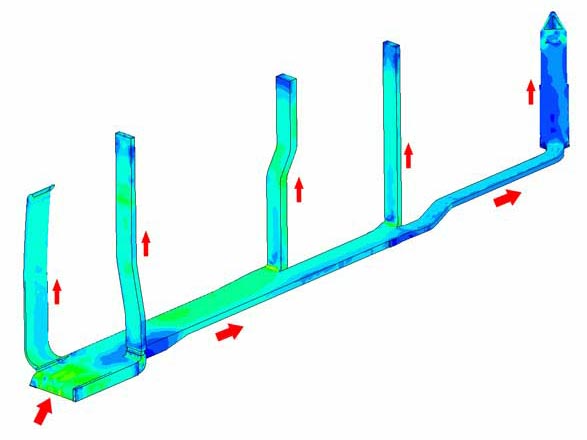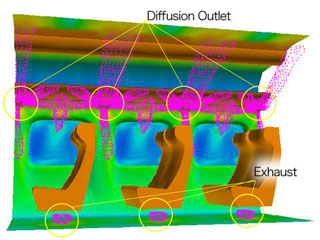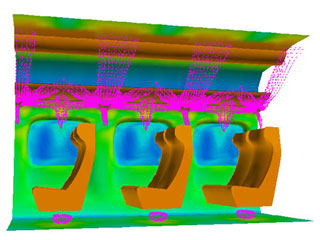Technology Numerical Simulation
Fluid Analysys
Tunnel Entry of Shinkansen Train
Shinkansen Train Runs into a Tunnel.
When Shinkansen train runs into a tunnel, big sound and vibration occur at the exit side of the tunnel.
It is generated
by a pressure wave originated from the entry of the train into
the tunnel. We calculate the pressure change at the instant of
the tunnel entry.
Higher pressure region becomes large when the train runs into
the tunnel. This pressure wave generates the big noise.
The pressure change becomes larger as the train runs faster. It
is important to make the pressure change smaller when designing
the leading nose shape of Shinkansen.
Fluid Analysis of Shinkansen Trains Passing Each Other in Tunnel
Shinkansen Trains Pass Each Other in Tunnel.
Shinkansen train is rolled when it passes each other in a tunnel. This phenomenon is caused by aerodynamic force. We analyze how the aerodynamic force works to Shinkansen carbodies when passing each other in a tunnel to improve passengers' comfort. In the figure, red shows high pressure area and blue shows low, and white lines show the streamlines around Shinkansen carbody A. In the side view figure, train B is transparent and the flow on the right-hand-side of train A is indicated.
side view with streamlines
bird's-eye view

Before passing, pressure near the noses of both train is very high.
When they begin to pass each other, the air on the right-hand-side of train A is pushed aside by train B. (streamline is very sparse).
Then train A is pushed away from train B. But, when the overlap of train A and B becomes large, pressure between both cars falls, and train A is pulled toward train B.
Train B also has the same experience in this process.
The rapid
pressure change is the source of rolling of Shinkansen trains.
Fluid Analysis in Air Conditioning Duct
Inside duct system
But a lot of useful information for design are available from the result of the numerical simulation.The figure shows the analysis result of sub-floor duct flow.

Air Conditioning Simulation of Passenger room of Shinkansen
Airconditioning Simulation
Airconditioning simulation gives us the temperature, the air flow speed and the air diffusion distribution in the passenger room. We will serve the more comfortable room for the passengers.
Designing Effective Air Conditioning Diffuser
Air conditioning Simulation
Air-conditioning simulation is carried out in order to make the cabin more comfortable.Heat from human body and outside of the train (through the wall) should be considered in this calculation.
 Initial design
Initial design
 After optimization
After optimization
Numerical Simulation Structual Analysys
Structual Analysys Fluid Analysys
Fluid Analysys Acoustic Analysys
Acoustic Analysys TestingüĢPhototyping
| Manufacturing Technology
TestingüĢPhototyping
| Manufacturing Technology